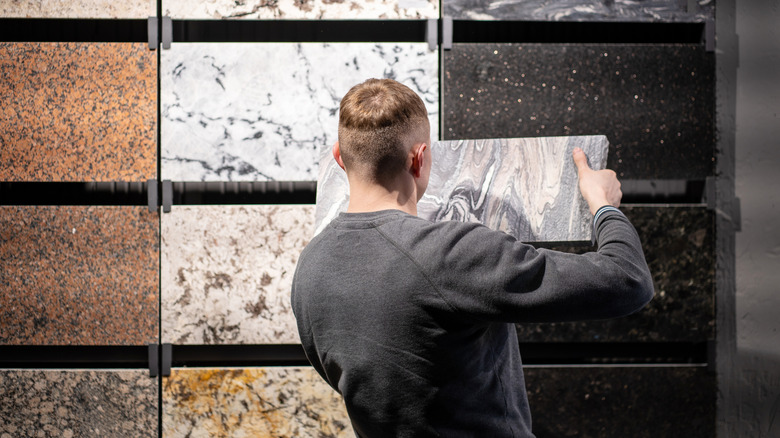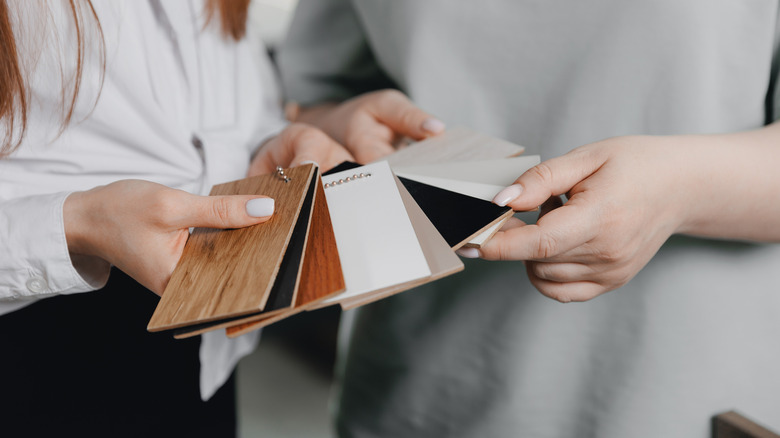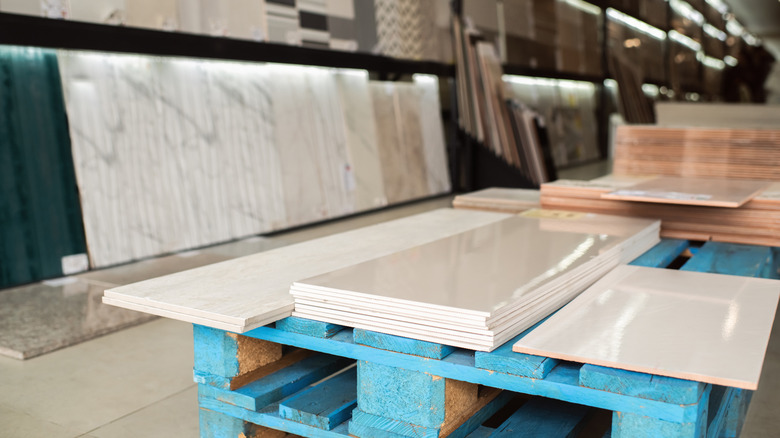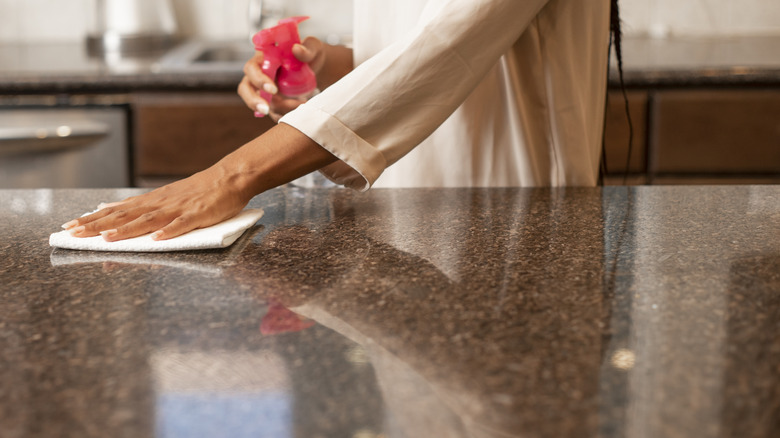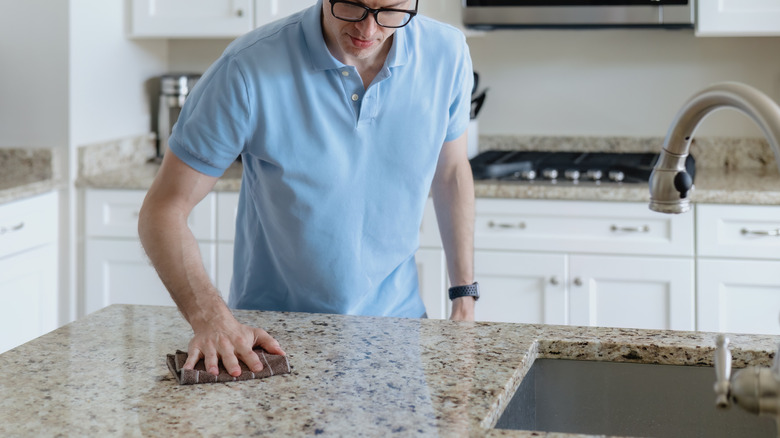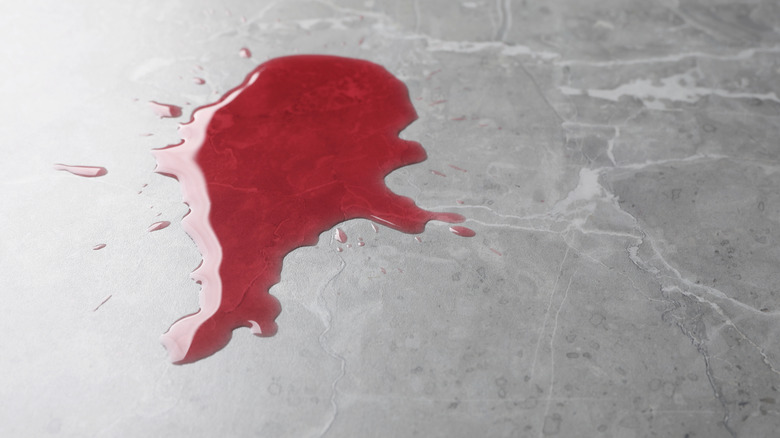12 Granite Countertop Mistakes To Avoid At All Costs
There are many reasons you might be considering getting new granite countertops installed — or why you already had them installed in your kitchen. Granite, which is a natural stone, is known for its durability. It is resistant against heat, scratches, stains, and moisture. You can also find a variety of color and pattern options, allowing you to create a custom look for your kitchen. Overall, granite is a relatively easy material to take care of, requiring less maintenance than marble and some other countertop options.
However, you shouldn't let the overall durability and ease of maintenance trick you into thinking that you can't do anything wrong with your granite countertops. There are actually several mistakes that people make with granite, including when selecting their new countertops, installing them, or using them, that can be detrimental. To help us learn more about these common mistakes to avoid — and what you should be doing instead — we reached out to three design and remodeling professionals for their expert input: Ariel Darmoni is the general manager at 123 Remodeling, Cathleen Gruver is the lead interior designer with Gruver Cooley, and Miriam Dillon is an interior designer at BarnesVanze Architects.
Assuming all granite is the same
One of the biggest mistakes you can make with granite countertops can occur before you have the slabs installed in your kitchen. Knowing that granite is a natural stone, it is easy to assume that all countertops will be the same. However, this couldn't be further from the truth — and choosing the wrong granite for your kitchen could prove to be a mistake. "Not all granite is created equal. Some slabs are more porous, some are harder, and color variation can be dramatic," explains Cathleen Gruver. The price difference may also be notable. So, while granite may often be more affordable than quartz, choosing the wrong slab could send your budget skyrocketing.
Ariel Darmoni also underscores how the differences between various granite slabs can have a huge impact on your renovation project. He says, "If you assume all granite behaves the same, you might end up with a high-maintenance surface when you were expecting something durable and low-fuss." To avoid this hassle, he recommends asking questions about the specific granite slabs that you're interested in to find out more about them and their care needs.
Waiting until too late in the design process to choose a granite slab
Regardless of whether you're designing the retro kitchen of your dreams or pulling together something with a sleek and modern feel, it is important not to wait too long to decide which granite slab you want to use. "Granite is a major visual anchor in the space, so I like to select it as early as possible — usually right after cabinet finishes and layout are finalized," shares Cathleen Gruver. She explains that waiting until you're deep into the design process could force you to squeeze a granite color and pattern into a design that it doesn't quite work with. Designing the rest of the palette around the stone is a much better option, according to Gruver.
However, while you want to decide what you want — or at least to have a general idea — early on, Miriam Dillon says, "You want to wait to finalize your selection [when] the contractor is ready and able to secure and store your material." Similarly, you'll need final cabinet measurements in order for the stone to be cut to ensure the right fit.
Forgetting samples of other design elements when shopping for granite
When you start shopping for granite, you shouldn't have empty hands. Instead, our design experts highlight the importance of bringing samples of the other finishes in your home kitchen. "I highly recommend bringing samples such as backsplash materials, cabinet door samples, and paint samples with you when looking at granite. You will want to see how it all works together," says Miriam Dillon. Take your time and really compare each of the elements you've already selected for your kitchen with each slab you're considering and think about how well they will (or won't) work together.
Beyond simply bringing the materials with you, Cathleen Gruver highlights the importance of viewing everything together in the best lighting. She recommends using natural lighting to get a good feel for what the different cabinet and backsplash materials will look like against the countertop. "Lighting changes everything, and what looked warm at home may pull cool in a stone yard," she explains. If the stones aren't already outside, consider asking a worker at the stone yard to move one or two that you're thinking about outside so you can compare them.
Failing to inspect the slab in person
If you're like many people, you might do a lot of your shopping online. You can buy clothes, books, presents, and even groceries online and have them all delivered to your home without even stepping foot in a store. You can even find granite slabs for sale online. However, just because someone is selling these slabs online doesn't mean that you should skip shopping in person for this big purchase.
According to Cathleen Gruver, "Granite can vary wildly even within a single lot. Choosing from a small sample or photo can lead to surprises — and not the good kind." You want to get a close-up view of the pattern on the stone, check out its luster, and really evaluate whether it is the right choice for your project. Remember, lighting can greatly impact what something looks like, so online photos may be very deceiving if they weren't properly lit. As mentioned above, you'll also want to see it right next to samples of your cabinets, flooring, and other finishes, which you won't be able to do through a phone or computer screen.
Thinking you can DIY a granite installation
If you're attempting a DIY kitchen remodel, you might think that you can also install your new granite countertops. What could be so hard, after all, about lining the stone up over the cabinets and securing it into place. A lot, actually. "Granite is pretty unforgiving. It's heavy, and it can crack if not handled right," says Ariel Darmoni. In addition to installing it, the stone also needs to be cut properly and precisely to fit over your cabinets and your kitchen sink. This will require special tools that you almost certainly don't have unless you work with stone countertops every day.
Instead of attempting to DIY a granite install, leave it to those who are experienced and have completed countless similar projects. "A professional team ensures proper support, seam placement, leveling, and sealing. It's worth the investment for something so permanent," notes Cathleen Gruver.
Forgetting to seal or reseal the surface
After your new countertops are set up, the installers will likely seal them. However, you shouldn't assume that this important task was completed, as it could spell trouble. Be sure to verify with the installers that they sealed the countertop for you. And if they didn't, make sure you do before you start using it. "Granite is naturally porous, so without sealing, liquids can penetrate the surface and cause stains. Over time, water and oils can seep in and leave permanent marks," explains Ariel Darmoni.
That initial sealing is important, but it is also important to reseal the stone to ensure it remains protected. Our experts recommend resealing granite every one to three years. Darmoni offers some advice to help you determine specifically when your stone should be resealed. "If you're unsure whether resealing is needed, pour a few drops of water on the surface — if it soaks in within minutes, it's time to reseal," he says.
While annual sealing may seem like a bit of a hassle, granite is actually lower maintenance than some other natural stones. For example, maintenance needs are one of the key differences between granite and marble countertops — marble can require resealing every few months.
Placing a hot pot on the countertop
You may have heard that this natural stone is heat resistant, so you might assume that it is okay to put a hot pot directly on a granite countertop. However, while you would be far from the only one to jump to this conclusion, you'd still be making a mistake if you were to do so.
"Granite is a heat-resistant material; however, it is not always recommended to place hot items directly on the surface, because the initial contact of the hot material on the granite could potentially cause cracking because of the quick temperature change," explains Miriam Dillon. Cathleen Gruver notes that the risk of thermal shock will be even greater if the slab is weakened or thinner. Instead of putting a hot pot or frying pan directly on the granite surface, both Gruver and Dillon recommend using a trivet or giving the cookware enough time to cool down.
Failing to clean your granite countertops regularly
You made the investment in purchasing nice granite countertops. You don't want to make the mistake of not giving them the care they need. One of the mistakes that many people make with granite is failing to clean it regularly. And according to our experts, this means that you should be cleaning your countertops daily. "A daily wipe down removes food residue, grease, and bacteria before they have a chance to settle," shares Ariel Darmoni.
Failing to follow this advice and waiting too long between cleanings opens up the possibility that you'll inadvertently damage the finish of the stone. "If you let grime, food acids, or oils sit too long, they can break down the seal and lead to staining or etching," says Cathleen Gruver. According to Gruver, a quick daily cleaning also helps maintain the beauty of the finish and the stone itself, ensuring it continues being an attractive asset in your kitchen.
Choosing the wrong cleaning products
Even if you stick to a daily cleaning schedule for your granite countertops, there is still another cleaning-related mistake you could end up making: using the wrong cleaning products. "Avoid anything acidic, abrasive, or overly harsh — like vinegar, bleach, ammonia, or citrus-based cleaners," says Cathleen Gruver. For those wondering why it's a bad idea to clean granite countertops with vinegar and these other harsh cleaners, Gruver explains, "These can eat away at the sealant and dull the surface. It's a common mistake to assume that 'natural' means safe, but lemon oil or vinegar can be just as damaging."
So, if you can't use vinegar, bleach, or other abrasive products when cleaning your granite countertops, what's left that is safe? "Use a pH-neutral granite cleaner or mild soap and water," suggests Ariel Darmoni. He adds, "I'd also recommend a soft microfiber cloth to avoid scratching the surface."
Cutting directly over your granite countertops
The durability and scratch resistance of granite may be two of the reasons you opted for this natural stone for your kitchen. However, while the stone certainly is more scratch resistant and durable than others, that doesn't mean that you should use it as a cutting board to cut meats, veggies, and other items without anything to protect it. "It's tempting — granite feels indestructible!" says Cathleen Gruver. However, she continues, "... Cutting directly on the surface can dull your knives and scratch the sealant, especially if the stone has softer minerals."
Instead of risking such damage to your granite countertop and your prized knives, you should always use a good cutting board when prepping meats, veggies, bread, and other items. Doing so will not only protect the granite from damage, but it will also help keep your knife set in good condition.
Letting spills sit for too long
In a busy kitchen, spills are inevitable. However, you don't want to let a spilled liquid sit on the surface of your granite countertops for too long. "I recommend wiping up spills immediately and cleaning surfaces on a regular basis," explains Miriam Dillon. "Even though it is a dense material, it is still porous, and spills left untreated could potentially cause damage or leave stains." While no spills are ideal, according to Ariel Darmoni, some are worse than others: "Oil and acidic foods are the most likely to cause stains — wine is probably the worst." However, water left to pool can also be highly problematic. "Over time, water spots or mineral build-up can occur, especially around fixtures," says Cathleen Gruver.
Furthermore, Darmoni highlights the importance of blotting, not wiping, when cleaning up a spill. Wiping, he explains, can cause the spill to spread to more areas of the countertop and could result in you rubbing it into the surface. "If something stubborn does soak in, use a poultice to draw it out," Gruver suggests.
If you're not familiar, a poultice is a special, absorbent paste that can help extract a liquid that could leave a stain. To make one, combine baby powder with a little hydrogen peroxide until it forms a thick paste. After adding a small amount of hydrogen peroxide directly over the affected area, spread a thick layer of the paste over the spot, cover it with plastic wrap, and let it sit for two days. By then, the paste should have dried out and hopefully extracted the liquid from your countertops. To remove the paste, simply add a little bit of water to it, and use a plastic spatula to scrape it off. Clean the countertop and let it dry.
Ignoring cracks or chips in your granite countertops
No one wants to think about cracks or chips on their granite countertops. However, these can, and do, happen. It can be tempting to just ignore the blemish or cover it up with your utensil holder, but this won't solve the problems — and it could actually make it worse. "Ignoring chips or cracks is risky. They tend to get worse with time, especially around sinks or cooktops where water and heat are constant," explains Ariel Darmoni. "Chips can collect grime, and cracks can lead to bigger structural issues."
When you act quickly, you can likely avoid many of these bigger issues. According to Cathleen Gruver, "If you catch a chip early, a professional can usually fill [it] with color-matched epoxy so it's nearly invisible." Miriam Dillon notes that you might also be able to fix some problems on your own. "Consider purchasing a granite repair kit to address smaller cracks," she says. Though, Dillon does still recommend turning to the pros for larger cracks.
You can also take steps to protect your granite countertops against additional damage. For example, placing a metal trivet under your slow cooker in addition to hot pots and pans can help prevent those annoying and unsightly cracks or chips.

